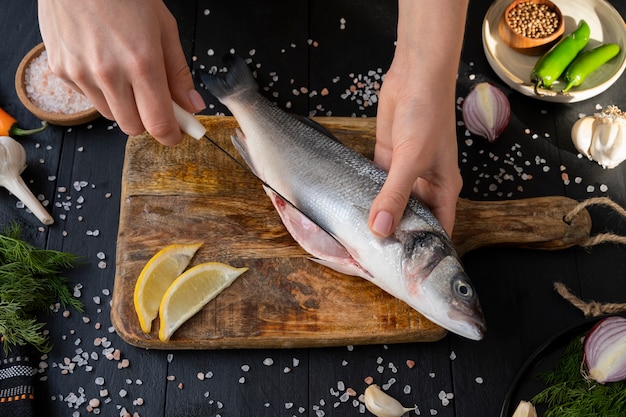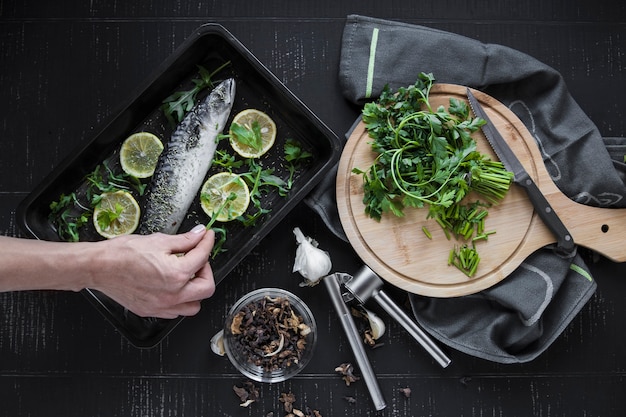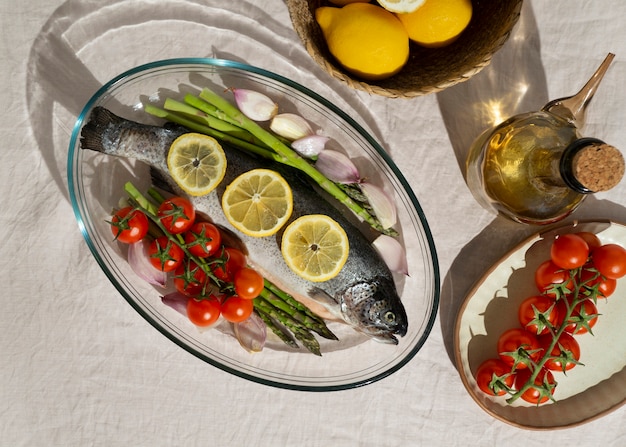Let's be honest, the thought of cooking a whole fish can be a little intimidating. All those scales, the guts, the bones... it seems like a recipe for disaster, right? But I'm here to tell you, it's not! Cooking a whole fish is actually quite straightforward, and the rewards are immense. I mean, have you ever tasted the incredible flavour of a perfectly cooked whole fish? It's truly something special.
As a seasoned cook who's tackled countless culinary challenges, I've learned that simplicity often leads to the most delicious results. And cooking a whole fish is definitely one of those simple pleasures. Plus, serving a beautiful whole fish at the dinner table is an absolute conversation starter. Your guests will be amazed at your culinary prowess!
So, are you ready to take the plunge and ditch the fish fillets? I'll guide you every step of the way, from selecting the perfect fish to serving it up with pride. Let's get started!
(Part 1) Selecting Your Fish: The Foundation of Flavour

Just like any good recipe, the key to success lies in starting with the right ingredients. Choosing the right fish is crucial for a delicious outcome. Here's what you need to know:
Choosing the Right Fish: A World of Options
The world of fish is vast, offering a diverse range of flavours and textures. Some popular choices for whole fish cooking include:
- Sea Bass: This firm-fleshed fish has a delicate flavour that's perfect for a variety of cooking methods.
- Cod: Known for its mild, slightly sweet flavour, cod is a versatile fish that's easy to cook.
- Snapper: A slightly more robust fish with a firm texture, snapper has a sweet, slightly buttery flavour.
- Bream: A lean and delicate fish with a mild flavour, bream is a great choice for grilling or baking.
- Salmon: A rich and oily fish with a distinctive flavour, salmon is a popular choice for baking or grilling.
Of course, there are many other wonderful fish to explore, depending on your taste and what's available in your local market.
Size Matters: Finding the Right Fit
The size of the fish is another important consideration. You want something big enough to feed your guests, but not so big that it becomes unwieldy. A fish that's about 1.5-2 pounds is a good starting point for a couple of people. If you're cooking for a larger group, you can opt for a bigger fish, or choose two smaller fish.
Freshness is King: Looking for the Right Signs
The freshness of the fish is absolutely paramount. Here are some telltale signs of fresh fish:
- Clear and Bright Eyes: The eyes should be clear, shiny, and not sunken in. Cloudy or sunken eyes indicate that the fish is not fresh.
- Vibrant Red Gills: The gills should be a vibrant red colour, not dull or brown. Brown or grey gills are a sign of spoilage.
- Firm Flesh: The flesh should be firm and springy to the touch. Avoid fish with mushy or flabby flesh.
- Fresh Smell: A fresh fish should have a clean, fresh ocean smell. If you notice any unpleasant odors, it's best to avoid that fish.
(Part 2) Preparing Your Fish: A Detailed Guide

Now that you've chosen your perfect fish, it's time to get it ready for cooking. The preparation process might seem a bit daunting, but I assure you, it's quite manageable. Let's break it down step by step:
Scaling Your Fish: Removing the Protective Layer
The first step is scaling the fish. This removes the protective layer of scales that can be unpleasant to eat. You can use a fish scaler, which is a specialized tool designed for this purpose, or you can use a sharp knife.
Using a Fish Scaler:
1. Hold the fish firmly.2. Start at the tail and scrape the scales away from the tail towards the head, using a light, back-and-forth motion.
Using a Sharp Knife:
1. Hold the knife at a 45-degree angle to the fish.2. Scrape the scales away from the head towards the tail, using a light, back-and-forth motion.
It's often helpful to scale the fish under a running tap, as the water washes away the scales as you go. After scaling, give the fish a good rinse to remove any remaining scales.
Gutting Your Fish: A Clean and Simple Process
The next step is gutting the fish, which involves removing the internal organs. This might seem a bit tricky, but it's actually quite simple:
1. Make an Incision: Cut a small incision along the belly of the fish, from the vent (the small hole near the tail) to the head. Be careful not to cut too deep, as you want to avoid damaging the flesh.
2. Remove the Guts: Carefully remove the guts with your fingers or a small spoon. Discard the guts and any other internal organs.
3. Snip the Membrane: Use a pair of kitchen scissors to snip the membrane along the belly, making it easier to remove the remaining guts.
It's important to rinse the fish thoroughly under cold water after gutting to remove any remaining debris. Pat the fish dry with paper towels.
Cleaning Your Fish: A Final Touch
Now, your fish is ready for the final cleaning. You can choose to leave the head and tail on or remove them, depending on your preference. Personally, I find that leaving them on adds a bit of rustic charm to the dish. If you decide to remove the head and tail, simply use a sharp knife to cut them off at the desired points.
Finally, give the fish one last rinse and pat it dry thoroughly. Your fish is now ready for seasoning and cooking!
(Part 3) Seasoning Your Fish: Unleashing Flavor

Seasoning is where you can truly make your fish shine! You can use a simple salt and pepper seasoning, or get more creative with a medley of herbs and spices. The choice is yours, but remember, simplicity often reigns supreme.
Simple Salt and Pepper: A Classic Combination
For a classic, clean flavour, salt and pepper are all you need. Generously season the inside and outside of the fish with salt and pepper, ensuring even coverage. You can also add a pinch of smoked paprika or cayenne pepper for a touch of warmth and depth.
Herbal Infusion: Aromatic Delights
For an aromatic infusion of flavour, experiment with a blend of herbs. Some popular choices include:
- Rosemary: Offers a slightly piney, earthy aroma.
- Thyme: Provides a subtle, slightly lemony flavour.
- Oregano: Adds a warm, earthy flavour with a hint of bitterness.
- Parsley: Provides a fresh, bright flavour and a vibrant green colour.
You can simply rub the herbs directly onto the fish, or create a herb paste by chopping the herbs and mixing them with olive oil and salt. Spread the herb paste generously over the fish before cooking.
Citrus Burst: A Zesty Addition
For a burst of citrusy brightness, incorporate lemon, lime, or orange zest. Zest adds a refreshing acidity that complements the delicate flavour of fish. Simply grate the zest over the fish or combine it with olive oil and herbs to create a marinade.
(Part 4) Choosing Your Cooking Method: From Oven to Grill
Now that your fish is seasoned and ready to go, it's time to choose your cooking method. Each method offers a unique flavour profile and texture, so choose one that best suits your taste and preferences.
Baking Your Fish: Gentle and Forgiving
Baking is a gentle and forgiving method that delivers moist and tender fish. Here's how to bake your fish to perfection:
1. Preheat Oven: Preheat your oven to 350°F (175°C). 2. Prepare Baking Sheet: Place the fish on a baking sheet lined with parchment paper. This prevents sticking and makes cleanup easier. 3. Bake: Bake for 20-25 minutes, or until the flesh is cooked through and flakes easily with a fork. You can add vegetables to the baking sheet for a one-pan meal. 4. Check for Doneness: To check for doneness, insert a fork into the thickest part of the fish. The flesh should flake easily with a fork.
Pan-Frying Your Fish: Quick and Crispy
Pan-frying is a quick and easy method that delivers a beautifully crispy skin. Here's how to achieve crispy perfection:
1. Heat Oil: Heat some olive oil in a large skillet over medium-high heat. Make sure the oil is hot enough before adding the fish.2. Cook Skin-Side Down: Carefully place the fish in the skillet, skin-side down. Cook for 5-7 minutes, or until the skin is golden brown and crispy.3. Flip and Cook: Flip the fish over and cook for another 3-5 minutes, or until the flesh is cooked through.4. Check for Doneness: Insert a fork into the thickest part of the fish. The flesh should flake easily with a fork.
Grilling Your Fish: Summertime Delight
Grilling is a perfect summertime method that imparts a smoky flavour and crispy skin. Here's how to grill your fish like a pro:
1. Preheat Grill: Preheat your grill to medium-high heat. Let the grill heat up thoroughly for optimal cooking. 2. Cook Skin-Side Down: Place the fish on the grill, skin-side down. Cook for 5-7 minutes, or until the skin is golden brown and crispy. 3. Flip and Cook: Flip the fish over and cook for another 3-5 minutes, or until the flesh is cooked through.4. Check for Doneness: Insert a fork into the thickest part of the fish. The flesh should flake easily with a fork.
You can add some lemon slices or herbs to the grill for extra flavour. Remember to keep an eye on the fish to prevent it from burning.
(Part 5) Serving Your Fish: Presentation is Key
The moment of truth! Your fish is cooked, and it's time to enjoy this culinary masterpiece. Here's how to present your fish in a way that's both beautiful and practical:
Presentation Matters: Creating an Appealing Display
You want to present your fish in a way that's visually appealing and makes it easy for your guests to enjoy. I always recommend using a platter or serving dish that's big enough to accommodate the fish and any sides.
Garnishing with Elegance: Enhancing the Visual Appeal
A few simple garnishes can elevate your dish to new heights. Here are some ideas for elegant finishing touches:
- Fresh Herbs: A sprinkle of chopped parsley, dill, or chives adds freshness and colour.
- Lemon Juice: A squeeze of lemon juice adds a bright acidity and enhances the flavour of the fish.
- Olive Oil: A drizzle of olive oil adds richness and shine to the fish.
- Citrus Slices: Thin slices of lemon, lime, or orange add a vibrant touch to the presentation.
Sides to Complete the Meal: Harmonizing Flavours
Don't forget to add some complementary side dishes to complete the meal. Here are some ideas:
- Roasted Vegetables: roasted asparagus, broccoli, or bell peppers complement the delicate flavour of the fish.
- Couscous: A light and fluffy grain that pairs well with grilled or baked fish.
- Rice: A classic and versatile side dish that complements a variety of fish flavours.
- Quinoa: A nutritious grain with a slightly nutty flavour that pairs well with fish.
- Salads: A refreshing and light side dish that balances the richness of the fish.
Remember to consider the flavours of your fish and the cooking method when choosing your side dishes.
(Part 6) Tips for Success: Mastering the Art of Whole Fish Cooking
Here are a few tips to help you cook a whole fish like a pro:
- Don't Overcook: Fish cooks very quickly, so it's important not to overcook it. Overcooked fish will be dry and tough.
- Use a meat thermometer: A meat thermometer is your best friend when cooking fish. The internal temperature should reach 145°F (63°C) for safe consumption.
- Keep the Skin On: The skin helps to keep the flesh moist and prevents it from sticking to the pan or grill. It also adds a nice crispy texture to the dish.
- Add Flavor to Your Cooking Liquid: For baked or poached fish, add herbs, spices, or lemon juice to the cooking liquid for extra flavour.
- Serve Immediately: Fish is best served fresh, as it will dry out if left standing for too long.
(Part 7) Storing Your Fish: Making the Most of Leftovers
Leftover whole fish? No worries! You can store leftover whole fish in the refrigerator for up to 2 days. Just be sure to wrap it tightly in plastic wrap or aluminum foil to prevent it from drying out.
You can also freeze leftover whole fish for up to 3 months. To freeze, wrap the fish tightly in plastic wrap, then place it in a freezer bag. Be sure to label the bag with the date.
(Part 8) FAQ: Addressing Your Common Questions
Let's tackle some of the common questions you might have about cooking whole fish.
What if the Fish is Too Big?
If the fish is too big to fit in your pan or oven, you can always cut it into smaller pieces. Simply cut through the backbone, separating the fish into two or three fillets. You can then cook the fillets as you would any other fish.
Can I Use Frozen Fish?
Absolutely! You can use frozen fish to cook a whole fish. Just be sure to thaw the fish completely before cooking. You can thaw it in the refrigerator overnight, or you can thaw it in cold water for a few hours. Don't thaw the fish at room temperature, as this can lead to bacterial growth.
What are Some Good Side Dishes for Whole Fish?
There are many delicious side dishes that pair beautifully with whole fish. Here are a few ideas to inspire your culinary creativity:
- Roasted Vegetables: Roasted asparagus, broccoli, or bell peppers provide a delightful contrast in texture and flavour.
- Couscous: A light and fluffy grain that absorbs the flavours of the fish and its seasonings.
- Rice: A classic and versatile side dish that complements a variety of fish flavours.
- Quinoa: A nutritious and flavourful grain that adds a touch of nuttiness to the meal.
- Salads: A refreshing and light side dish that balances the richness of the fish.
How Do I Know When the Fish is Cooked?
The fish is cooked when the flesh is opaque and flakes easily with a fork. You can also use a meat thermometer to check the internal temperature. The internal temperature should reach 145°F (63°C) for safe consumption.
What if I Don't Have a Fish Scaler?
If you don't have a fish scaler, you can use a sharp knife to remove the scales. Just be sure to hold the knife at a 45-degree angle and scrape the scales away from the tail to the head. You can also ask your fishmonger to scale the fish for you before you buy it.
Now, go forth and conquer the world of whole fish cooking! With this comprehensive guide, you'll be a fish-cooking pro in no time. Happy cooking!
Everyone is watching

Corn on the Cob: The Ultimate Guide to Perfectly Cooked Ears
Healthy MealsAh, corn on the cob. Just the name evokes images of sunny days, barbecues, and that sweet, juicy flavour that ...

Scallops: The Ultimate Guide to Perfect Cooking
Healthy MealsAh, scallops. Those delicate, sweet, and utterly delicious morsels of the sea. They hold a special place in my...

Spaghetti Squash: The Ultimate Guide to Cooking and Serving
Healthy MealsRemember that time you saw spaghetti squash at the supermarket, looking all bumpy and strange, and thought, "W...

Salmon Cooking Times: Perfect Guide for Every Recipe
Healthy MealsLet me tell you, cooking salmon is an art form. It's all about getting that perfect balance: juicy and tender,...

Ham Cooking Time: How Long to Bake, Smoke, or Boil a Delicious Ham
Healthy MealsAh, ham. It's a classic, isn't it? A real crowd-pleaser, especially around holidays. And when done right, it'...
